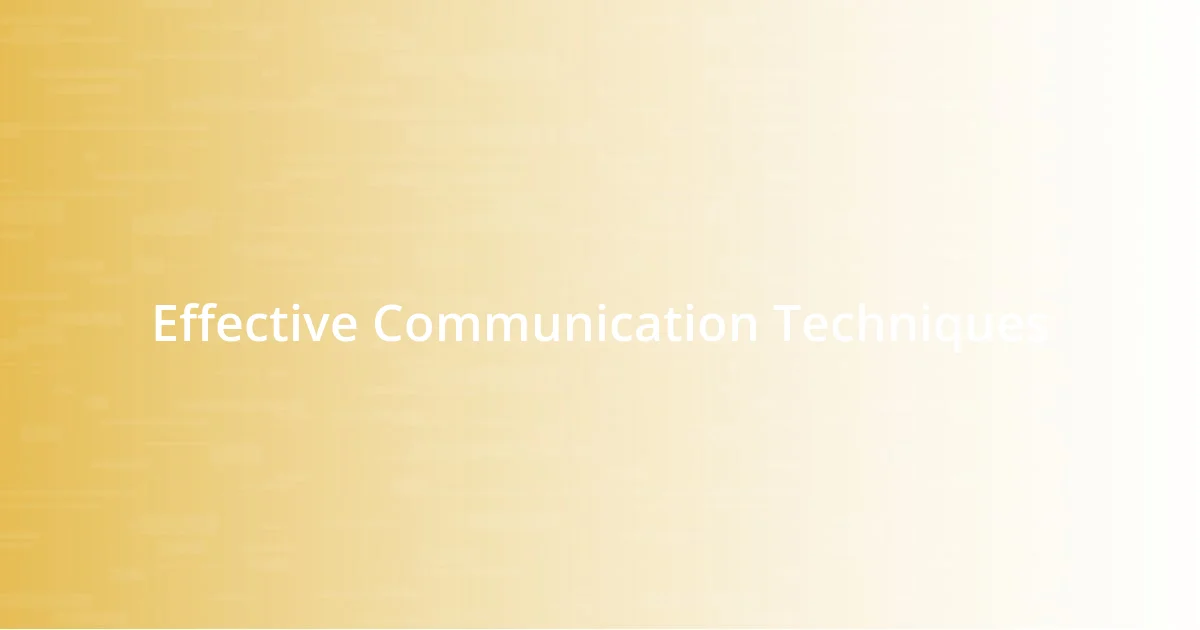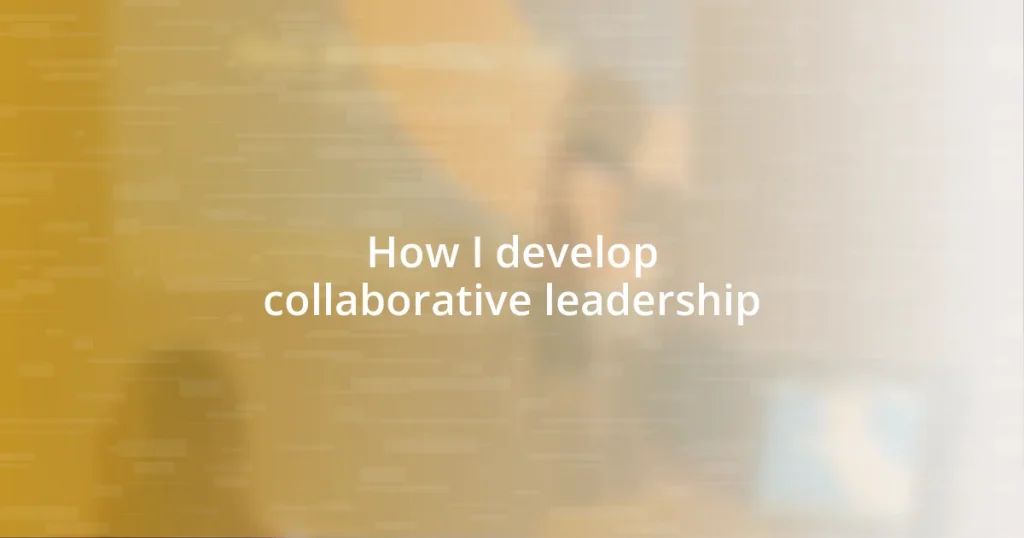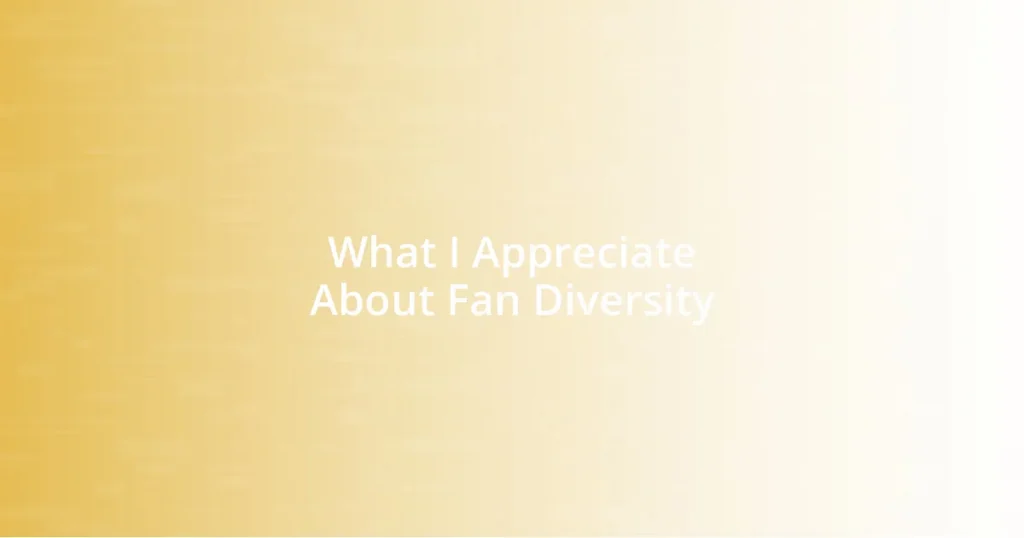Key takeaways:
- Collaborative leadership thrives on open communication, trust, and shared ownership, enhancing team creativity and engagement.
- Key characteristics of collaborative leaders, such as empathy, adaptability, and inclusiveness, foster an environment conducive to teamwork and innovation.
- Effective communication, recognizing individual strengths, and celebrating diversity are essential strategies to deepen team engagement and measure collaboration’s impact.

Understanding Collaborative Leadership
Collaborative leadership is all about fostering partnerships and teamwork in pursuit of shared goals. I remember a time when I led a project where every team member contributed their unique skills, which not only boosted creativity but also morale. It made me wonder: isn’t it fascinating how collaboration can turn a group of individuals into a powerhouse of innovation?
What strikes me most about collaborative leadership is its emphasis on open communication and trust. In my experience, trust emerges when leaders genuinely value their team’s input, creating an atmosphere where everyone feels empowered to share ideas without fear of judgment. Have you seen how this can lead to unforeseen breakthroughs? I certainly have, and it’s a reminder of the untapped potential that lies within diverse perspectives.
Moreover, collaborative leadership encourages a sense of ownership and accountability among team members. I recall feeling a profound sense of responsibility when leading a cross-functional team where everyone had a stake in the outcome. It’s incredible to see how a team that feels invested in the project is often far more engaged and productive. Could this sense of ownership be the secret ingredient to a thriving team dynamic?

Key Characteristics of Collaborative Leaders
Collaborative leaders possess a unique blend of qualities that foster an environment ripe for teamwork. For instance, I’ve seen firsthand how empathy shapes interactions within a team. When I worked on a project that faced numerous hurdles, my willingness to listen to my colleagues’ frustrations not only alleviated tensions but also unified our purpose. Empathy is not just about understanding; it’s about connecting on a human level, which can significantly enhance collaboration.
Here are key characteristics that define collaborative leaders:
- Empathy: They genuinely understand their team members’ perspectives and emotions.
- Trustworthiness: Honesty and integrity inspire confidence and open communication.
- Adaptability: They pivot easily in response to new information or changes, encouraging flexibility among team members.
- Visionary Thinking: Effective leaders communicate a compelling vision that aligns the team’s efforts.
- Inclusive Decision-Making: They invite input from all members, making everyone feel valued and heard.
Reflecting on my experience, I’ve noticed that when these characteristics are cultivated, they transform the team dynamics. In a recent collaboration, navigating differing opinions became seamless because each person felt respected. As I often remind myself, the essence of collaborative leadership lies in nurturing those attributes that ignite collective effort.

Building Trust Within Teams
Building trust within teams is a foundational element of successful collaborative leadership. I vividly recall a time when I encouraged transparency by sharing both triumphs and failures in our projects. This honesty not only deepened our connections but also fostered a culture where team members felt safe to take calculated risks. The sigh of relief I witnessed as people opened up about their challenges was a powerful reminder of how trust can transform team dynamics.
Trust is built through consistency and reliability in our actions. I remember establishing regular one-on-one check-ins with my team members, creating a space where they could express concerns or share progress. By being present and attentive, I found that my team felt more secure and motivated. It struck me how simply being available and receptive could strengthen the bonds of trust. Have you ever noticed how little gestures build a sense of belonging?
A team thrives when trust is mutual. In my experience, setting clear expectations and being honest about my goals created a shared roadmap that everyone could rally around. During one particular project, assigning roles based on individual strengths allowed us to move confidently toward our collective aim, confirming that trust isn’t just about feelings—it’s about creating a solid framework through which everyone can succeed.
| Aspect | Building Trust |
|---|---|
| Transparency | Sharing successes and failures to create a culture of openness |
| Reliability | Consistently being available and responsive to team needs |
| Mutual Understanding | Setting clear expectations and recognizing individual strengths |

Effective Communication Techniques
Effective communication is the backbone of collaborative leadership. I remember a project where miscommunication nearly derailed our progress. By implementing regular team huddles—brief, focused meetings—I noticed a remarkable shift. It was during these updates that we could quickly address concerns and celebrate small wins, making everyone feel more connected and aligned. Have you ever felt the power of simply reconnecting with your team?
Active listening is another crucial communication technique I’ve found invaluable. During a brainstorming session, I made a point to echo back what others said before sharing my thoughts. This practice not only validated their contributions but also created an environment where everyone felt comfortable expressing their ideas. The positive energy in the room was infectious; it reminded me of how much we can achieve when we truly hear one another.
Nonverbal cues also play a significant role in communication. I recall attending a workshop where a facilitator beautifully illustrated how body language could reinforce or undermine our messages. I started to pay closer attention to my posture, eye contact, and facial expressions during interactions. I realized that my enthusiasm needed to be visible, not just audible. How often do we overlook the impact of our nonverbal signals? Strengthening our communication toolkit in this way can elevate our collaborative efforts to new heights.

Balancing Authority and Collaboration
Balancing authority and collaboration can often feel like walking a tightrope. In my role as a leader, I’ve learned that it’s essential to establish a clear framework while allowing team members the freedom to contribute their ideas. There was a time when I had to make a quick decision on a project direction. Instead of dictating the choice, I presented the available options and asked for input. The result? A shared sense of ownership that led to greater enthusiasm and accountability among the team. Doesn’t it feel rewarding when everyone feels like they’ve played a part in the outcome?
At times, authority is necessary to keep the team focused and aligned, but I also believe collaboration breeds innovation. I recall a situation where differing opinions led to a heated discussion. Instead of shutting it down, I facilitated a dialogue where each perspective was heard. This approach not only diffused tension but also sparked creative solutions that I hadn’t even considered. How often do we miss out on great ideas simply because we don’t take the time to explore various viewpoints?
Ultimately, the key lies in knowing when to assert authority and when to step back and listen. I remember mentoring a new leader who struggled with this balance. I encouraged her to experiment with different scenarios: sometimes steering the conversation, other times leaning back and letting the team take the lead. Witnessing her growth and confidence was gratifying, highlighting that understanding this balance is a journey. Isn’t it fascinating how the dance between authority and collaboration continually shapes our leadership practices?

Strategies for Fostering Team Engagement
Fostering team engagement requires intentional strategies that resonate with individual team members. In one project I led, I noticed that implementing personalized goal-setting sessions transformed how my team connected with their tasks. Sharing their aspirations not only motivated them but also made their contributions feel more meaningful. Have you ever experienced the difference when you’re genuinely invested in your goals?
Another strategy I’ve embraced is celebrating diversity in opinions. During a recent workshop, I divided my team into smaller groups to brainstorm ideas separately before regrouping. Each team brought forth unique perspectives, and the energy in the room was electric. Seeing their ideas flourish and interconnect was a gratifying moment for me; it highlighted how differences can enrich our collaborative efforts. What if we made it a point to tap into every voice around the table?
I also find that creating a culture of recognition plays a vital role in engagement. I remember a time when I implemented a “team shout-out” system in our weekly meetings, where everyone had the chance to acknowledge a colleague’s effort. The simple act of expressing gratitude ignited a wave of positivity and camaraderie that rippled through our work. Have you thought about how a little recognition can boost morale?

Measuring the Impact of Collaboration
Measuring the impact of collaboration can be a revealing experience. In one instance, after implementing a new collaborative tool within my team, I decided to survey everyone about their communication and project efficiency. The feedback was astonishing; many reported a noticeable increase in productivity and clarity. Isn’t it amazing how a simple change can have such a profound effect?
I also focus on outcomes by setting clear, measurable goals for collaborative projects. For example, in a recent initiative, we aimed to reduce project turnaround time by 20%. Monitoring our progress not only kept us accountable but also highlighted the tangible benefits of working together. When I shared our success at the conclusion, the sense of achievement amongst the team was palpable. Can you imagine the satisfaction of seeing direct results from collective effort?
Additionally, I find that observing team dynamics during collaboration provides insight into its impact. During a brainstorming session, I noticed how individuals who typically held back began contributing actively when encouraged. Their enthusiasm not only sparked creativity but also fostered a supportive environment. Reflecting on that moment, it became clear to me that collaboration isn’t just about outcomes; it’s about nurturing a culture where everyone feels valued. Do you see how vital it is to create spaces conducive to open dialogue?















